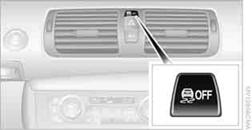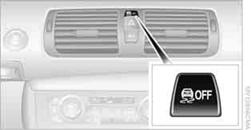Driving stability control systems
Your BMW has a number of systems that help to maintain the vehicle's stability even in adverse driving conditions.
Antilock Brake System ABSABS prevents locking of the wheels during braking. Safe steering response is maintained even during full braking. Active safety is thus increased.
The ABS is operational every time you start the engine. Braking safely.
Electronic brake-force distribution EBVThe system controls the brake pressure in the rear wheels to ensure stable braking behavior.
Dynamic Brake Control DBCWhen you apply the brakes rapidly, this system automatically produces the maximum braking force boost and thus helps to achieve the shortest possible braking distance during full braking. This system exploits all of the benefits provided by ABS.
Do not reduce the pressure on the brake for the duration of the full braking application.
Dynamic Stability Control DSCDSC prevents the driving wheels from losing traction when you pull away from rest or accelerate. The system also recognizes unstable driving conditions, for example if the rear of the car is about to swerve or if momentum is acting at an angle past the front wheels. In these cases, DSC helps the vehicle maintain a safe course within physical limits by reducing engine output and through braking actions at the individual wheels.
 The laws of physics cannot be repealed, even with DSC. An appropriate driving style always remains the responsibility of the
driver. Therefore, do not reduce the additional safety margin again by taking risks,
as this could result in an accident.
The laws of physics cannot be repealed, even with DSC. An appropriate driving style always remains the responsibility of the
driver. Therefore, do not reduce the additional safety margin again by taking risks,
as this could result in an accident.
Deactivating DSC

Press the button for at least 3 seconds until the indicator lamp for DSC OFF lights up and DSC OFF is displayed in the instrument panel. Dynamic Traction Control DTC and DSC have been simultaneously deactivated. Stabilizing and drive-output promoting actions are no longer executed.
In the same way as with a differential interlock, even if DSC is deactivated, brake actions are still performed on the rear axle to enhance drive output if the drive wheels experience a significant loss of traction.
To increase vehicle stability, activate DSC again as soon as possible.
Activating DSC
Press the button again; the indicator lamp in the instrument panel goes out.
For better control
 If the indicator lamp flashes: the DSC controls the driving and braking forces.
If the indicator lamp flashes: the DSC controls the driving and braking forces.
If the indicator lamp lights up: DSC and
DTC have failed.
 The indicator lamp lights up and
The indicator lamp lights up and
DSC OFF is displayed in the instrument panel: DSC is deactivated.
Dynamic Traction Control DTCDTC is a version of DSC in which the drive output is optimized for particular road conditions, e.g. unplowed snow-covered roads. The system assures the maximal drive output, but with reduced driving stability. It is therefore necessary to drive with appropriate caution.
You may find it useful to briefly activate DTC under the following special circumstances:
> When driving uphill on snow-covered roads, in slush or on unplowed, snow-covered
roads
> When rocking a stuck vehicle free or starting off in deep snow or on loose ground
> When driving with snow chains
Activating DTC

Press the button; the indicator lamp for DSC OFF lights up and TRACTION is displayed in the instrument panel.
For better control
 If the indicator lamp flashes: DTC controls the
driving and braking forces.
If the indicator lamp flashes: DTC controls the
driving and braking forces.
If the indicator lamp lights up: DSC and
DTC have failed.
 The indicator lamp lights up and TRACTION is
displayed in the instrument panel: DTC is activated.
The indicator lamp lights up and TRACTION is
displayed in the instrument panel: DTC is activated.
Deactivating DTC
Press the button again; the indicator lamp in the instrument panel goes out.
See also:
PDC Park Distance Control
The concept
In addition to the PDC Park Distance Control, the
backup camera*, can be
switched on.
PDC supports you when parking. Objects that
you are approaching slowly in front of or behind
...
Displaying stored Check Controlmessages
1. "Vehicle Info"
2. "Vehicle status"
3. "Check Control"
4. Select the text message. ...
The concept
The vehicle can be accessed without activating
the remote control.
All you need to do is to have the remote control
with you, e.g., in your jacket pocket.
The vehicle automatically detects the ...
